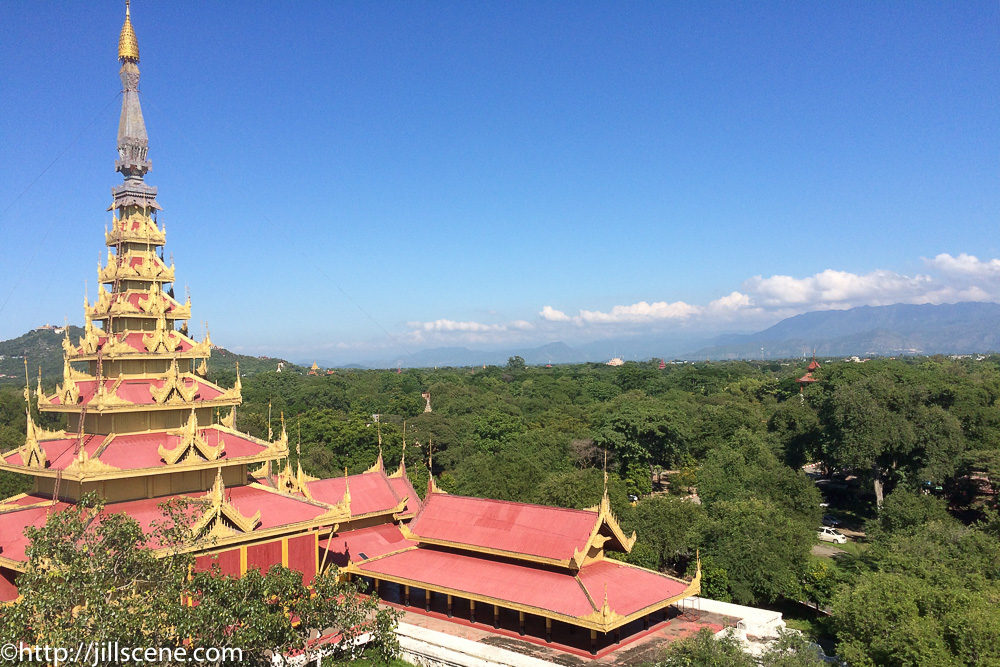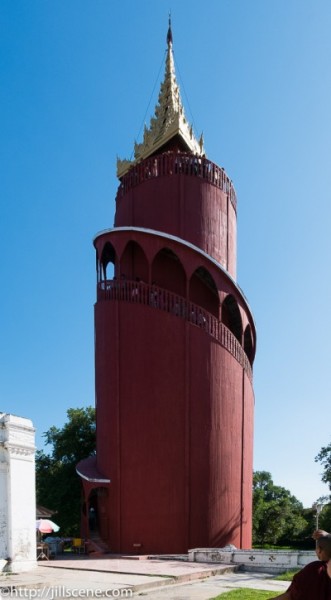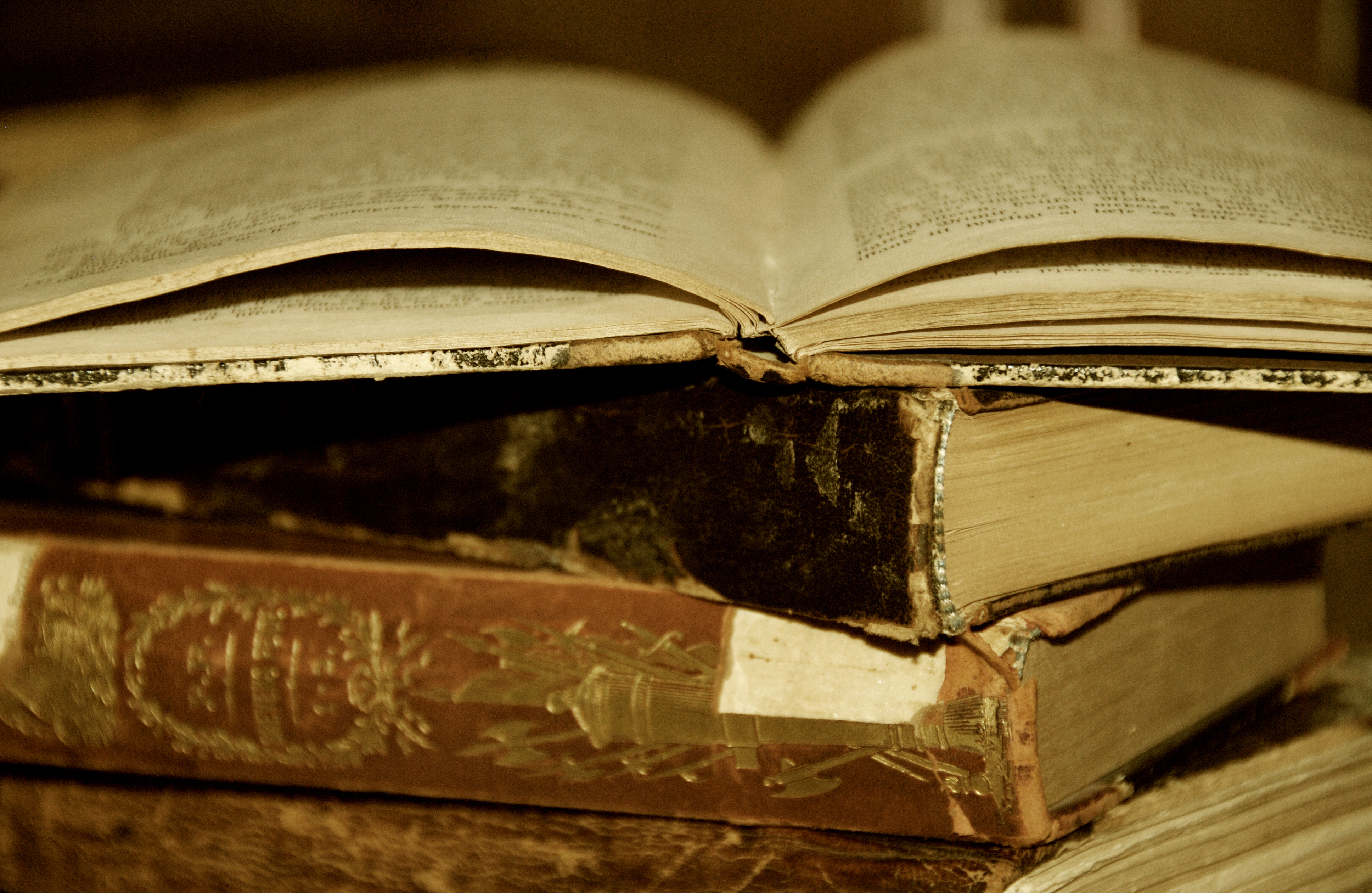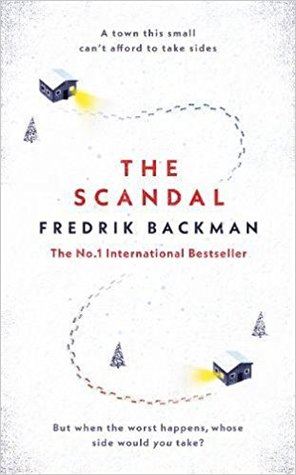I first travelled to Mandalay in the pages of Amitav Ghosh‘s The Glass Palace. Through the eyes of his protagonist, the young Rajkumar, I was there when the British fleet sailed up the Irrawaddy River. I was with Queen Supayalat when, alarmed at the boom of the British canons, she climbed the stairs of the guard tower to see for herself what was happening. I was there when the soldiers ransacked the palace, when the British commander exiled King Thibaw, forcing him to travel through the streets of Mandalay on a bullock drawn cart.
And so it was a foregone conclusion that I would visit the Royal Palace in Mandalay.

View over the palace complex from the guard tower
I expected my skin to make goosebumps the way it did when I read the introductory pages of this epic novel. I wondered if I might get the heebie geebies remembering the story of how so many of the royal family were slaughtered to ensure Thibaw’s ascension was secure. I didn’t.
The palace would once have been sumptuous and ornate, a grand palace that showed off the wealth of Burma. Goodness me, it had eight separate throne rooms! Although this replica, built in the 1990s, gives an impression of the layout of the complex and the style of architecture, the rooms themselves are dusty, dry, and largely empty. (The original Royal palace was destroyed during World War II.)
There is a cultural museum at the rear of the palace grounds. It was a cool spot to while away some time, to wonder at the lives of the kings and their households. Unfortunately, photos were prohibited.

Looking in the general direction of the Irrawaddy River from the guard tower
The watch tower which I’ve mentioned before is, as I understand it, original.

Watch Tower, Mandalay Palace, Myanmar
The day John and I visited, there were a lot of people climbing the stairs to the top and, unnervingly, it shook a bit. Halfway was far enough for me.
Nevertheless, here, for a brief moment, I imagined Queen Supayalat, heavily pregnant, alarmed at the sound of the British canon and desperate for information, climbing these same stairs just as Ghosh describes. Assuming the sun shone that day, brilliant strategist that some say Queen Supayalat was, she’s unlikely to have taken the time to notice the play of light on the stairs.

Patience rewarded me with a few seconds alone on the stairs, and a chance at this shot of the play of light through the balustrades.
The palace is situated in the heart of a modern day military complex in Mandalay. Security is tight. There’s a rigmarole before gaining access which involves registering at the gate just over the moat, under the close scrutiny of machine gun-toting soldiers, and then a drive through the military complex before arriving at the entrance to the Palace itself.
Once you’re inside the palace grounds it does feel a little more relaxed and I thought well worth the visit.

Principal palace rooms and the famed nine tier tower above the Great Hall
Amitav Ghosh’s The Glass Palace spans more than one hundred years. It is set in Burma, Malaya, and India and follows the fortunes of the fictitious Rajkumar and his family from the time of the deposing of King Thibaw to the Burma of the 1990s.
From the fall of the Burmese Kingdom, to the Raj, to the Japanese air attack on Rangoon, to the great march from Burma to India by so many thousands of ethnic Indians, to the recent military rule of Burma, I imagined myself inside the lives of the characters. That’s what a good book does—it tells stories, and it tells them in such a way it reminds me, despite our vast differences in lived experiences and ways of making sense of the world, how similar we all are.
And it made me think of the Jewish saying Isabel Allende refers to in the opening of her TED Talk:
What is truer than truth?
Answer: The story
The Glass Palace is the only novel I’ve read by Amitav Ghosh. His more recent novel Sea of Poppies (2008) was shortlisted for the Booker prize. Have you read any of his work?
The Glass Palace
Amitav Ghosh (2001) Harper Collins. Paperback Edition
Categories: Myanmar (Burma), Off-shore Adventures, On Books





btw, reading about the Andes???
LikeLike
Well spotted 😉
LikeLike
A Place I have always wanted to visit.
LikeLiked by 1 person
Me too, and I still can’t quite believe we’ve actually booked the tickets!
LikeLike
I’m all excited for you. I’ll pack my cyber suitcase too. When do you go?
LikeLiked by 1 person
The middle of June, it’ll come around quickly now.
LikeLike
How long will you be travelling this time?
LikeLiked by 1 person
Another interesting book to put on my list Jill. Last night I watched a “Foreign correspondent” documentary about the opium poppy growing in Myanmar, called “poppyland”. Did you come across any of that side of the country? It said they try to keep that hidden from tourists. I think you would find it an interesting programme.
LikeLike
That does sound like an ineresting programme, Pauline. I was aware that it is a problem but we saw no signs of it at all.
LikeLike
It seems the Shan tribes are trapped into growing the poppies as it is the only way they can make a living. They are exploited by the opium traders.
LikeLiked by 1 person
Isn’t that always the way? It’s the same with the jade mines in the Kachin state. Tourists are prohibited from going near there, as well, apparnetly the conditions of the mines are dire.
LikeLike
Very sad to hear of indigenous people exploited all over the world.
LikeLiked by 1 person
Besides The Glass Palace, I also read The Hungry Tide and Sea of Poppies. I liked The Hungry Tide more but that might just be because the region in which it is set sounds so captivating and magical in his description.
LikeLiked by 1 person
Hello perelincolors, Both are on my ever expanding “must read” list, perhaps The Hungry Tide will be first up. Thank-you for reading and commenting on my post.
LikeLiked by 1 person
As always, Jill, I am so glad you bring us along with you on these trips.
LikeLiked by 1 person
More adventures coming soon, Dan 😉
LikeLiked by 1 person
Great to know about the place!
LikeLiked by 1 person
Go, if you get the chance—it’s an amazing place.
LikeLiked by 1 person
Sure I will!
LikeLiked by 1 person
I second Su!
LikeLiked by 1 person
I really enjoying my vicarious trip to Myanmar. These are lovely images, and a book recommendation is always welcome. 😀
LikeLiked by 2 people
Thanks so much, Su!
LikeLiked by 1 person
Love the perspectives!
LikeLiked by 1 person
Welcome to my blog, InherentlyAdventurous. I appreciate your feedback.
LikeLiked by 1 person
Love your post – I really enjoyed both the book and my visit to the palace a couple of years back when I was in Mandalay.
LikeLiked by 1 person
Gee, thanks and welcome to my blog! Mandalay is a fascinating city.
LikeLike
Excellent post, Jill! Thanks so much for sharing the trip and the book! 🙂
LikeLiked by 1 person
Hi there Fabio, great to know you enjoyed the post.
LikeLiked by 1 person
Hi there Jill! Have a wonderful Sunday and keep posting so nicely! Thank you! 🙂
LikeLiked by 1 person